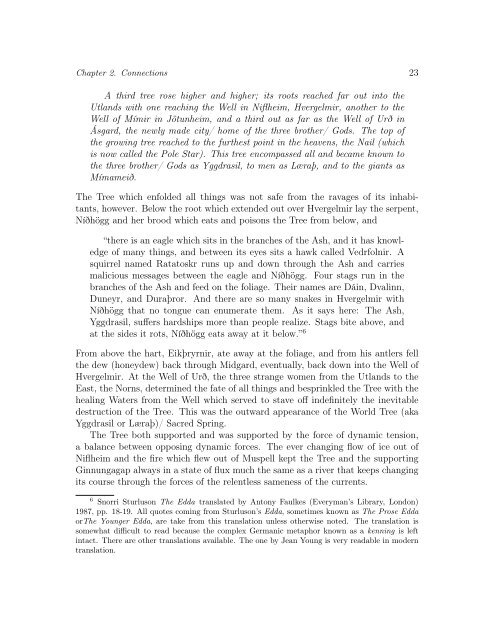Untitled - Awaken Video
Untitled - Awaken Video
Untitled - Awaken Video
Create successful ePaper yourself
Turn your PDF publications into a flip-book with our unique Google optimized e-Paper software.
Chapter 2. Connections 23<br />
A third tree rose higher and higher; its roots reached far out into the<br />
Utlands with one reaching the Well in Niflheim, Hvergelmir, another to the<br />
Well of Mímir in Jötunheim, and a third out as far as the Well of Urð in<br />
Ásgard, the newly made city/ home of the three brother/ Gods. The top of<br />
the growing tree reached to the furthest point in the heavens, the Nail (which<br />
is now called the Pole Star). This tree encompassed all and became known to<br />
the three brother/ Gods as Yggdrasil, to men as Læraþ, and to the giants as<br />
Mímameið.<br />
The Tree which enfolded all things was not safe from the ravages of its inhabitants,<br />
however. Below the root which extended out over Hvergelmir lay the serpent,<br />
Níðhögg and her brood which eats and poisons the Tree from below, and<br />
“there is an eagle which sits in the branches of the Ash, and it has knowledge<br />
of many things, and between its eyes sits a hawk called Vedrfolnir. A<br />
squirrel named Ratatoskr runs up and down through the Ash and carries<br />
malicious messages between the eagle and Níðhögg. Four stags run in the<br />
branches of the Ash and feed on the foliage. Their names are Dáin, Dvalinn,<br />
Duneyr, and Duraþror. And there are so many snakes in Hvergelmir with<br />
Níðhögg that no tongue can enumerate them. As it says here: The Ash,<br />
Yggdrasil, suffers hardships more than people realize. Stags bite above, and<br />
at the sides it rots, Níðhögg eats away at it below.” 6<br />
From above the hart, Eikþryrnir, ate away at the foliage, and from his antlers fell<br />
the dew (honeydew) back through Midgard, eventually, back down into the Well of<br />
Hvergelmir. At the Well of Urð, the three strange women from the Utlands to the<br />
East, the Norns, determined the fate of all things and besprinkled the Tree with the<br />
healing Waters from the Well which served to stave off indefinitely the inevitable<br />
destruction of the Tree. This was the outward appearance of the World Tree (aka<br />
Yggdrasil or Læraþ)/ Sacred Spring.<br />
The Tree both supported and was supported by the force of dynamic tension,<br />
a balance between opposing dynamic forces. The ever changing flow of ice out of<br />
Niflheim and the fire which flew out of Muspell kept the Tree and the supporting<br />
Ginnungagap always in a state of flux much the same as a river that keeps changing<br />
its course through the forces of the relentless sameness of the currents.<br />
6 Snorri Sturluson The Edda translated by Antony Faulkes (Everyman’s Library, London)<br />
1987, pp. 18-19. All quotes coming from Sturluson’s Edda, sometimes known as The Prose Edda<br />
orThe Younger Edda, are take from this translation unless otherwise noted. The translation is<br />
somewhat difficult to read because the complex Germanic metaphor known as a kenning is left<br />
intact. There are other translations available. The one by Jean Young is very readable in modern<br />
translation.
















